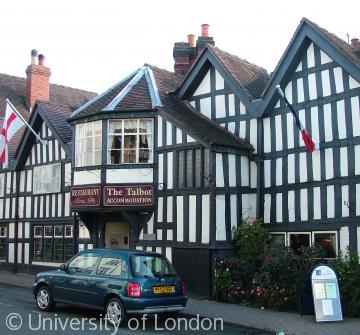Pubs and Inns
 The Talbot Inn, New Street, Ledbury, believed to date from 1596
The Talbot Inn, New Street, Ledbury, believed to date from 1596Pubs, Inns, Alehouses and Taverns are an ever present element of English villages, towns and cities. Recorded in documents from as early as the 10th century, the alehouse was an ordinary house in which ale was sold which also provided basic food and accommodation for travellers. Due to their domestic nature, no pre-Conquest alehouse sites have been identified. Later alehouses retained this basic feel, with beer served in jugs from the barrel and buildings with a very small number of rooms offering very basic amenities.
The tavern appeared in the 12th and 13th centuries and was more closely associated with larger towns and the wine trade. These buildings differed from alehouses in that they did not generally offer accommodation and by the 17th century had developed into sophisticated structures offering rooms for general and private use and a more comfortable drinking experience which, along with the imported wines, appealed to the middle and upper classes. By 1800 the tavern had ceased to exist as a distinct form of drinking establishment, although many modern pubs retain 'tavern' in their names.
Inns, which also appeared in the 12th and 13th centuries, were different from pubs, alehouses and taverns as they were primarily concerned with providing accommodation for travellers. Often identifiable by the carriage entrance, courtyard and stabling required for the traveller's horses, most sizable settlements had an inn by the 15th century. These numbers grew in the 17th century with the development of the coaching trade, spawning the coaching inn which flourished in smaller towns along the coaching routes from London until the establishment of the railways in the mid-19th century. Although many survive today, and some still offer overnight accommodation, in general they have lost their original function and now fulfill much the same function as the public house.
The most numerous and recognizable kind of drinking establishment is the public house, which replaced the term alehouse in the mid-17th century, coinciding with the provision of more sophisticated facilities, which by the mid-18th included rooms set aside specifically for drinking and the incorporation of 'the bar' which was already in existence in taverns and inns. The number of pubs dramatically increased with the birth of the beer house, a largely mid-19th century creation which developed as a result of the 1830 Beer Act (a response to the perceived evils of the gin shop) that granted a license to serve beer to any ratepayer who could pay the annual Excise Fee. Beer houses (as the name suggests) were only licensed to sell beer, unlike the fully licensed public houses, although many of these fully licensed pubs began life as beer houses.
The relative freedom of the Beer Act did not continue, leading in the 1890s to breweries (such as Guinness) looking to acquire licensed public houses to sell their beer, thus beginning a system of brewery owned and controlled pubs that is still in place today.










